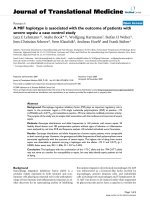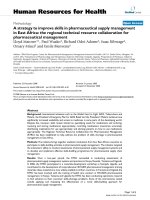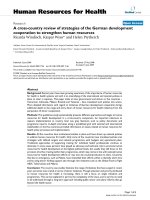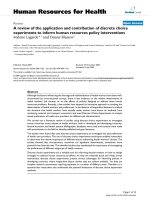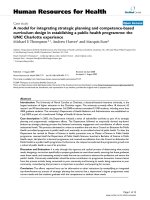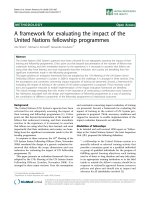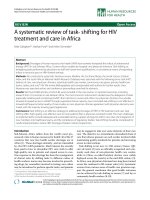Báo cáo sinh học: " A high-performance quantum-dot superluminescent diode with two-section structure" potx
Bạn đang xem bản rút gọn của tài liệu. Xem và tải ngay bản đầy đủ của tài liệu tại đây (765.73 KB, 15 trang )
This Provisional PDF corresponds to the article as it appeared upon acceptance. Fully formatted
PDF and full text (HTML) versions will be made available soon.
A high-performance quantum-dot superluminescent diode with two-section
structure
Nanoscale Research Letters 2011, 6:625 doi:10.1186/1556-276X-6-625
Xinkun Li ()
Peng Jiu ()
Qi An ()
Zuocai Wang ()
Xueqin Lv ()
Heng Wei ()
Jian Wu ()
Ju Wu ()
Zhanguo Wang ()
ISSN 1556-276X
Article type Nano Express
Submission date 8 September 2011
Acceptance date 12 December 2011
Publication date 12 December 2011
Article URL />This peer-reviewed article was published immediately upon acceptance. It can be downloaded,
printed and distributed freely for any purposes (see copyright notice below).
Articles in Nanoscale Research Letters are listed in PubMed and archived at PubMed Central.
For information about publishing your research in Nanoscale Research Letters go to
/>For information about other SpringerOpen publications go to
Nanoscale Research Letters
© 2011 Li et al. ; licensee Springer.
This is an open access article distributed under the terms of the Creative Commons Attribution License ( />which permits unrestricted use, distribution, and reproduction in any medium, provided the original work is properly cited.
A high-performance quantum dot superluminescent diode with a two-section
structure
Xinkun Li
1
, Peng Jin*
1
, Qi An
1
, Zuocai Wang
1
, Xueqin Lv
1
, Heng Wei
1
, Jian Wu
1
, Ju
Wu
1
, and Zhanguo Wang
1
1
Key Laboratory of Semiconductor Materials Science, Institute of Semiconductors,
Chinese Academy of Sciences, Beijing, 100083, China
*Corresponding author:
Email addresses:
XL:
PJ:
QA:
ZW:
XL:
HW:
JW:
JW:
ZW:
Abstract
Based on InAs/GaAs quantum dots [QDs], a high-power and broadband
superluminescent diode [SLD] is achieved by monolithically integrating a
conventional SLD with a semiconductor optical amplifier. The two-section QD-SLD
device exhibits a high output power above 500 mW with a broad emission spectrum
of 86 nm. By properly controlling the current injection in the two sections of the
QD-SLD device, the output power of the SLD can be tuned over a wide range from
200 to 500 mW while preserving a broad emission spectrum based on the balance
between the ground state emission and the first excited state emission of QDs. The
gain process of the two-section QD-SLD with different pumping levels in the two
sections is investigated.
Keywords: quantum dot; superluminescent diode; two-section structure; optical
amplification.
Introduction
Superluminescent diodes [SLDs] have attracted extensive attention for a wide range
of applications, such as optical coherence tomography [OCT] [1, 2], optical
fiber-based sensors [3-5], external cavity tunable lasers [6-8], optoelectronic systems
[9], etc. A wide emission spectrum corresponding to a low degree of coherence is
required for these applications of SLD, which allows the realization of sensors with
improved resolution. It has been proposed that self-assembled quantum dots [QDs]
[10-12] and quantum well grown on a high-index surface are beneficial to broaden the
spectral bandwidth of the device [13]. Till now, QDs have successfully been used as
the active media in several broadband light-emitting devices, such as QD-SLDs
[14-20], QD semiconductor optical amplifiers [SOAs] [21-23], and QD broadband
laser diodes [24-26]. For QD-SLD devices, a high power of 200 mW [14] and a wide
spectral bandwidth of more than 140 nm [27, 28] have been achieved. Most recently,
an intermixed QD-SLD exhibits a power of 190 mW with a 78-nm spectral bandwidth
[29].
For a typical SLD device structure with a single current-injection section, the high
output power can only be obtained at a high pumping level, where the device
demonstrates a narrow spectrum emitted predominantly from the QDs' excited state
[ES] due to the low saturated gain of the QD ground state [GS]. It is difficult to
achieve high-power and broad-emitting spectrum simultaneity. However, a
high-power SLD that is broadband emitting is required in some fields. As an example,
in an OCT system, a high power is usually needed to enable greater penetration depth
and improve the imaging sensitivity [30]. Numerical investigation [31] and
experimental evidence [32, 33] have shown that this limitation can be overcome by
using a multi-section structure in an SLD device, which allows the emission spectrum
and output power to be tuned independently. A quantum-well SLD with a two-section
structure which integrates monolithically an SLD with an SOA has been reported,
which exhibits an output power that is one or two orders of magnitude higher than that
in conventional SLD devices [34].
In this paper, a QD-SLD device, which has a two-section structure monolithically
integrating an SLD with an SOA, is fabricated. A high power (500 mW) with a broad
emission of 86 nm is obtained. By properly controlling the current injection in the two
sections of the QD-SLD device, the power tunability over a wide range from 200 to
500 mW is achieved, with the preservation of a nearly constant spectral width.
Experiment
The epitaxial structure of the QD-SLD device in this study was grown by a Riber 32P
solid-source molecular beam epitaxy machine on n-GaAs(001) substrate. The
epitaxial structure consists of ten InAs-QD layers separated from each other by a
GaAs spacer; each of them is formed by depositing a 1.8-monolayer InAs at 480°C
and covered by a 2-nm In
0.15
Ga
0.85
As. Ten QD layers plus the GaAs waveguide layers
form the whole active region which is sandwiched between 1.5-µm n- and p-type
Al
0.5
Ga
0.5
As cladding layers. Finally, a p
+
-doped GaAs contact layer completes the
structure.
A QD-SLD device with an index-guided ridge waveguide and a two-section
structure was fabricated. A schematic diagram of the geometrical design (not to scale)
is shown in Figure 1. The device integrates monolithically an SLD with a tapered
SOA. The SLD section is 1-mm long and 10-µm wide. The tapered SOA section is
3-mm long with a full flare angle of 6°. The ridge waveguide was fabricated using
photolithography and wet chemical etching. The center axis of the ridge is aligned at
6° with respect to the facet normal to suppress lasing. A 200-µm-length output
window structure (no electric contact) is used to reduce the risk for catastrophic
optical damage of the output facet with a high output power. Ti/Au and AuGeNi/Au
ohmic contacts were evaporated on the top and back of the wafer, respectively. A
20-µm-wide separation between the SLD and the SOA sections is realized by
removing the upper Ti/Au ohmic contact and the 0.5-µm epilayer using
photolithography and wet chemical etching. After metallization, the device was
cleaved and mounted p-side up on a copper sink using an indium solder.
Antireflection coatings of λ/4 were used on both facets of the device. The QD-SLD
device was characterized by light power-injection current [P-I] and
electroluminescence measurements at room temperature under a pulsing (1 kHz
repetition rate and 3% duty cycle) injection in the SOA section and a continuous-wave
injection in the SLD section, respectively.
Results and discussion
Figure 2 shows the P-I characteristic of the SOA section with the SLD section
un-pumped and acting as a rear optical absorption region. A superluminescent
characteristic is clearly observed by the superlinear increase in optical power with the
current. At a current of 9.8 A, a maximum output power of 280 mW is obtained. The
emission spectra under different injection currents in the SOA section [I
SOA
] are
shown in the inset of Figure 2. When I
SOA
= 2 A, the center wavelength of the
emission spectrum is 1.18 µm with a full width at half maximum of 43 nm, which
corresponds to the QDs' GS emission. The relatively wide GS emission is attributed to
the size inhomogeneity that is naturally occurring in self-assembled QDs. With the
increasing I
SOA
, the emission spectra are clearly broadened to the short-wavelength
side, which should be attributed to the sequential carrier filling into the first ES [ES1].
For a given I
SOA
of 8.35 A, due to the nearly identical contribution to the emission
from the QDs' GS and ES1, a 94-nm broad spectrum with a power of 200 mW is
achieved.
The characteristics of the two-section SLD device were measured when the SLD
section was pumped to seed the SOA section. The output-power characteristics versus
I
SOA
under different SLD section currents [I
SLD
] are shown in Figure 3. It can be seen
from the figure that the output power increases rapidly with the increasing current
injection in the SLD section. Without pumping the SLD section, the output power of
the device is 280 mW at I
SOA
= 9.8 A. The output power can reach 1.15 W at I
SOA
=
9.8 A and I
SLD
= 400 mA. The device begins lasing when the power is in the range of
500 to approximately 600 mW with various SOA and SLD current combinations
(refer to Figure 4). The evident increase of output power is attributed to the
amplification of the input beam while propagating forward from the narrow end to the
wide end of the tapered region. With a full flare angle of 6°, the incident beam will
expand freely to fill the full tapered region owing to diffraction [35]. The optical
density will be reduced, which increases the saturated power.
The emission spectra measured from the SOA facet under different I
SLD
, with
I
SOA
fixed at 6.5, 8.5, and 9.5 A, respectively, are shown in Figure 5. As expected, it
can be seen from the figure that the spectrum shape and emission bandwidth of the
QD-SLD device with the two-section structure can be tuned by properly controlling
the current injection in the two sections. With I
SOA
fixed at 6.5 A as shown in Figure
5a, the GS emission provides the main contribution to the spectrum when the SLD
section is not pumped. To obtain a more broadened emission bandwidth based on the
balance of the QDs' GS and ES1 emissions, the input beam from the SLD section
must provide a greater amount of ES emission. When the SLD section is driven with
400 mA of current-injection in order to seed the SOA section, the resultant emission
of the QDs' GS and ES1 have nearly equivalent contributions, and a 76-nm bandwidth
is obtained. At this working point, the device gives a 320-mW power output. Similarly,
a broad emission spectrum based on the balance between the GS emission and the
ES1 emission of QDs is achieved at I
SLD
= 200 and 100 mA for a given I
SOA
of 8.5
and 9.5 A, respectively. With I
SOA
fixed at 8.5 A, when the SLD section is driven with
a 200-mA current-injection to seed the SOA section, the QD-SLD device exhibits a
broad emission spectrum of 86 nm and a simultaneous high output power of 504 mW.
For a given I
SOA
of 9.5 A, with the SLD section un-pumped, the ES1 emission
provides the main contribution to the emission spectrum. In order to achieve a
balanced emission from GS and ES1, the GS-dominated emission is introduced to the
SOA using I
SLD
= 100 mA. As a result, the resultant contribution of the QDs' GS and
ES1 is equivalent. A broad emission spectrum of 88 nm with the output power of 422
mW is obtained.
It can be seen from the above results that the output power and spectrum
bandwidth can be tuned by properly controlling the current densities injected in the
two regions of the QD-SLD. Figure 4 shows equal power curves as function of the
currents injected in the two sections. Data points (solid squares) at which the GS and
ES1 have nearly identical emission intensities, corresponding to the maximum
bandwidth of the emission spectrum, are also shown in Figure 4. It can be found that
the output power can be tuned over a wide range of 200 to 500 mW while preserving
a broad emission spectrum. The high output power and wide power tunability is due
to the two-section structure which integrates a tapered SOA section. Current
combinations at which the device begins lasing are also shown in Figure 4 (solid
circles). Working points of the QD-SLD device can be set in the lower left region of
the borderline. An optimum working point is found in the figure that the SOA current
is in the 8- to approximately 8.5-A range and the SLD current is 0.2 to approximately
0.25 A, at which a 500-mW output power and an 86-nm bandwidth are achieved
simultaneously.
Conclusion
In conclusion, a high-power QD SLD with a broad bandwidth in the emission spectra
is achieved by the two-section structure which monolithically integrates an SLD with
a tapered SOA. Properly controlling the current densities injected in the two sections,
the QD-SLD device exhibits a maximum output power above 500 mW and a
simultaneously broad bandwidth of 86 nm. Also, the output power can be tuned over a
wide range from 200 to 500 mW while preserving a nearly constant spectral width.
Competing interests
The authors declare that they have no competing interests.
Authors' contributions
XL carried out the device process, device characterization, and data analysis;
participated in the experimental design; and drafted the manuscript. PJ conceived the
study, participated in its design and coordination, and performed the epitaxial growth.
QA participated in the data analysis. ZW participated in its design and carried out
some preparative work. XL participated in the epitaxial growth. HW participated in
the device process. JW participated in the device process. JW modified the draft. ZW
conceived the study. All authors read and approved the final manuscript.
Acknowledgments
This work was supported by the National Basic Research Program of China (no.
2006CB604904) and the National Natural Science Foundation of China (nos.
60976057, 60876086, and 60776037).
References
1. Schmitt JM: Optical coherence tomography (OCT): a review. IEEE J Sel Topics
Quantum Electron 1999, 5:1205-1215.
2. Zotter S, Pircher M, Torzicky T, Bonesi M, Götzinger E, Leitgeb RA, Hitzenberger
CK: Visualization of microvasculature by dual-beam phase-resolved Doppler
optical coherence tomography. Opt Express 2011, 19:1217-1227.
3. Burns WK, Chen C, Moeller RP: Fiber-optic gyroscopes with broad-band
sources. J Lightw Technol 1983, 1:98-105.
4. Lee B: Review of the present status of optical fiber sensors. Opt Fiber Technol
2003, 9:57-79.
5. Krstajić N, Childs D, Smallwood R, Hogg R, Matcher SJ: Common path
Michelson interferometer based on multiple reflections within the sample arm:
sensor applications and imaging artifacts. Meas Sci Technol 2011, 22:027002.
6. Lv XQ, Jin P, Wang ZG: Broadly tunable grating-coupled external cavity laser
with quantum-dot active region. IEEE Photon Technol Lett 2010, 22:1799-1801.
7. Lv XQ, Jin P, Wang WY, Wang ZG: Broadband external tunable quantum dot
lasers with low injection current density. Opt Express 2010, 18:8916-8922.
8. Fedorova KA, Cataluna MA, Krestnikov I, Livshits D, Rafailov EU: Broadly
tunable high-power InAs/GaAs quantum-dot external cavity diode lasers. Opt
Express 2010, 18:19438-19443.
9. Li X, Cohen AB, Murphy TE, Roy R: Scalable parallel physical random number
generator based on a superluminescent LED. Opt Lett 2011, 36:1020-1022.
10. Sun Z-Z, Ding D, Gong Q, Zhou W, Xu B, Wang ZG: Quantum-dot
superluminescent diode: a proposal for an ultra-wide output spectrum. Opt
Quantum Electron 1999, 31:1235-1246.
11. Meng XQ, Jin P, Liang ZM, Liu FQ, Wang ZG, Zhang ZY: Structure and
properties of InAs/AlAs quantum dots for broadband emission. J Appl Phys 2010,
108:103515.
12. Wu J, Wang ZM, Dorogan VG, Li S, Mazur YI, Salamo GJ: Near infrared
broadband emission of In
0.35
Ga
0.65
As quantum dots on high index GaAs surfaces.
Nanoscale 2011, 3:1485-1488.
13. Li Z, Wu J, Wang ZM, Fan D, Guo A, Li S, Yu S, Manasreh O, Salamo GJ:
InGaAs quantum well grown on high-index surfaces for superluminescent diode
applications. Nanoscale Res. Lett. 2010, 5:1079-1084.
14. Zhang ZY, Wang ZG, Xu B, Jin P, Sun ZZ, Liu FQ: High-performance
quantum-dot superluminescent diodes. IEEE Photon Technol Lett 2004, 16:27-29.
15. Li LH, Rossetti M, Fiore A, Occhi L, Velez C: Wide emission spectrum from
superluminescent diodes with chirped quantum dot multilayers. Electron Lett
2005, 41:41-43.
16. Rossetti M, Markus A, Fiore A, Occhi L, Velez C: Quantum dot
superluminescent diodes emitting at 1.3 µm. IEEE Photon Technol Lett 2005,
17:540-542.
17. Djie HS, Dimas CE, Wang D-N, Ooi B-S, Hwang JCM, Dang GT, Chang WH:
InGaAs/GaAs quantum-dot superluminescent diode for optical sensor and
imaging. IEEE Sensors J 2007, 7:251-257.
18. Zhang ZY, Luxmoore IJ, Jin CY, Liu HY, Jiang Q, Groom KM, Childs DT,
Hopkinson M, Cullis AG, Hogg RA: Effect of facet angle on effective facet
reflectivity and operating characteristics of quantum dot edge emitting lasers
and superluminescent light-emitting diodes. Appl Phys Lett 2007, 91:081112.
19. Haffouz S, Rodermans M, Barrios PJ, Lapointe J, Raymond S, Lu Z, Poitras D:
Broadband superluminescent diodes with height-engineered InAs-GaAs
quantum dots. Electron Lett 2010, 46:1144-1146.
20. Zhang ZY, Jiang Q, Hopkinson M, Hogg RA: Effects of intermixing on
modulation p-doped quantum dot superluminescent light emitting diodes. Opt
Express 2010, 18:7055-7063.
21. Bakonyi Z, Su H, Onishchukov G, Lester LF, Gray AL, Newell TC, Tünnermann
A: High-gain quantum-dot semiconductor optical amplifier for 1300 nm. IEEE J
Quantum Electron 2003, 39:1409-141.
22. Wong HC, Ren GB, Rorison JM: Mode amplification in inhomogeneous QD
semiconductor optical amplifiers. Opt Quantum Electron 2006, 38:395-409.
23. Park J, Kim NJ, Jang YD, Lee EG, Lee JM, Baek JS, Kim JH, Lee HS, Yee KJ,
Lee D, Pyun SH, Jeong WG, Kim J: Gain dynamics of an InAs/InGaAsP quantum
dot semiconductor optical amplifier operating at 1.5 µm. Appl Phys Lett 2011,
98:011107.
24. Sugawara M, Mukai K, Nakata Y: Light emission spectra of columnar-shaped
self-assembled InGaAs/GaAs quantum-dot lasers: effect of homogeneous
broadening of the optical gain on lasing characteristics. Appl Phys Lett 1999,
74:1561-1563.
25. Kovsh A, Krestnikov I, Livshits D, Mikhrin S, Weimert J, Zhukov A: Quantum
dot laser with 75 nm broad spectrum of emission. Opt Lett 2007, 32:793-795.
26. Zhukov AE, Kovsh AR: Quantum dot diode lasers for optical communication
system. Quantum Electron 2008, 38:409-423.
27. Zhang ZY, Hogg RA, Xu B, Jin P, Wang ZG: Realization of extremely
broadband quantum-dot superluminescent light-emitting diodes by rapid
thermal-annealing process. Opt Lett 2008, 33:1210-1212.
28. Lv XQ, Liu N, Jin P, Wang ZG: Broadband emitting superluminescent diodes
with InAs quantum dots in AlGaAs matrix. IEEE Photon Technol Lett 2008,
20:1742-1744.
29. Jiang Q, Zhang ZY, Hopkinson M, Hogg RA: High performance intermixed
p-doped quantum dot superluminescent diodes at 1.2 µ
µµ
µm. Electron Lett 2010,
46:295-U49.
30. Brezinski ME, Fujimoto JG: Optical coherence tomography: high-resolution
imaging in nontransparent tissue. IEEE J Sel Topics Quantum Electron 1999,
5:1185-1192.
31. Rossetti M, Bardella P, Montrosset I: Numerical investigation of power
tenability in two-section QD superluminescent diodes. Opt Quantum Electron 2008,
40:1129-1134.
32. Xin Y-C, Martinez A, Saiz T, Moscho AJ, Li Y, Nilsen TA, Gray AL, Lester LF:
1.3-µm quantum-dot multisection superluminescent diodes with extremely broad
bandwidth. IEEE Photon Technol Lett 2007, 19:501-503.
33. Greenwood PDL, Childs DTD, Groom KM, Stevens BJ, Hopkinson M, Hogg RA:
Tuning superluminescent diodes characteristics for optical coherence
tomography systems by utilizing a multicontact device incorporating
wavelength-modulated quantum dots. IEEE J Sel Topics Quantum Electron 2009,
15:757-763.
34. Du GT, Devane G, Stair KA, Wu SL, Chang RPH, Zhao YS, Sun ZZ, Liu Y, Jiang
XY, Han WH: The monolithic integration of a superluminescent diode with a
power amplifier. IEEE Photon Technol Lett 1998, 10:57-59.
35. Walpole JN: Semiconductor amplifiers and lasers with tapered gain regions.
Opt Quantum Electron 1996, 28:623-645.
Figure 1. Schematic diagram of the QD-SLD device with a two-section structure.
Figure 2. P-I characteristic of the SOA section with the SLD section un-pumped.
The inset shows the normalized emission spectra under different injection currents of
the SOA section.
Figure 3. Output power versus SOA current under different injection currents of
the SLD section.
Figure 4. Equal power curves (solid lines) as function of the currents injected in
the two sections. The solid squares show the combinations of currents at which QDs'
GS and 1st ES give equivalent contributions to the emission spectra. Current
combinations at which the device begins lasing are shown in solid circles.
Figure 5. Normalized emission spectra from the SOA facet under different
pumps of the SLD section. They are for a given SOA injection of (a) 6.5, (b) 8.5,
and (c) 9.5 A, respectively. Some spectra are shifted vertically for clarity.
Figure 1
Figure 2
Figure 3
Figure 4
Figure 5
